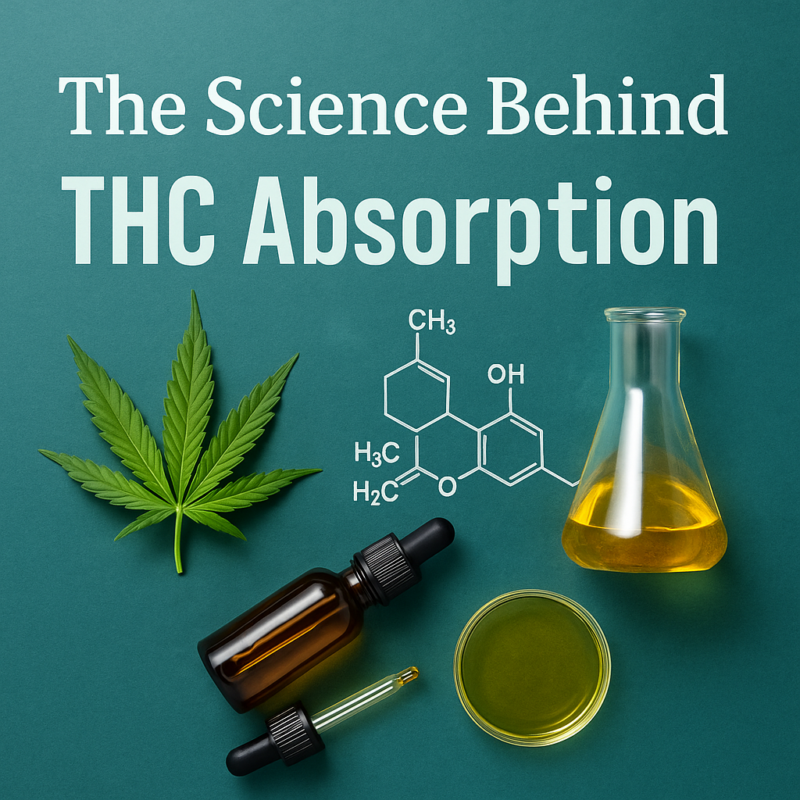
Understanding how THC interacts with the body and why your experience may vary
Introduction
If you’ve ever tried a THC product and wondered why the effects hit you differently than your friend—or why some edibles take forever to kick in—you’re not alone. The absorption of THC (tetrahydrocannabinol) is a complex biological process that depends on more than just dosage.
Behind every cannabis experience is a mix of chemistry, biology, and delivery method that determines how—and how fast—THC reaches your brain. This article explores the science of THC absorption, how it varies from person to person, and what to keep in mind when choosing how you consume.
1. What Happens When You Ingest THC?
At its core, THC is a fat-soluble compound, meaning it binds to fat rather than dissolving in water. When you consume THC—whether by inhalation, ingestion, or topical application—it must pass through certain biological systems before producing psychoactive effects.
With inhalation (smoking or vaping), THC enters the bloodstream almost instantly through the lungs, leading to effects that begin within minutes. With edibles, the journey is slower and more complex: THC travels through the digestive system, is metabolized by the liver, and then enters circulation.
This difference in pathway explains why edibles tend to take 30 minutes to 2 hours to kick in but may last significantly longer than inhaled THC.
2. Bioavailability: Not All THC Is Absorbed
Not every milligram of THC you consume reaches your brain. The bioavailability of THC—the proportion that enters circulation and has an active effect—depends on the consumption method.
- Smoking or Vaping: Bioavailability ranges from 10–35%, with rapid onset (2–10 minutes).
- Edibles: Bioavailability is lower, around 4–12%, and delayed due to digestion and liver metabolism.
- Sublingual (under the tongue): Offers quicker absorption through mucous membranes, bypassing the digestive tract.
- Topicals: Mostly act locally and are not usually psychoactive unless formulated for transdermal absorption.
Your metabolism, body fat percentage, and even what you’ve eaten recently can all influence how much THC your body absorbs and how long it stays in your system.
3. The Role of the Liver: Why Edibles Feel Different
When you eat a THC-infused product, it’s broken down in the liver, where a portion of the THC is converted into 11-hydroxy-THC—a compound considered to be even more potent and longer-lasting than delta-9 THC (the kind you inhale).
This metabolite is believed to be responsible for the intense, body-focused effects often associated with edibles. It also explains why some users report feeling “more high” or experience deeper relaxation or sedation from edibles compared to smoking.
4. Why Everyone Reacts Differently
There’s no universal THC experience—and there’s good reason for that. Several personal factors influence how THC affects you:
- Genetics: Variations in enzymes (especially in the CYP family) impact how efficiently your body metabolizes THC.
- Tolerance: Regular users may require higher doses to achieve the same effect.
- Body Fat: Because THC binds to fat, people with higher body fat may store THC longer and experience effects differently.
- Diet and Hydration: A high-fat meal can increase the absorption of edible THC, while dehydration can intensify its effects.
- Endocannabinoid System (ECS): This complex cell-signaling system varies in sensitivity from person to person and plays a key role in how THC interacts with your body.
5. Nanoemulsions and New Technology
In recent years, the cannabis industry has embraced nanotechnology to improve THC absorption. Nanoemulsified THC refers to THC particles broken down into nano-sized droplets, which allows them to be absorbed faster and more efficiently by the body.
Many fast-acting beverages and sublingual sprays now use this technology, offering effects in as little as 10–15 minutes, with a smoother onset curve and less unpredictability than traditional edibles.
While still a developing space, nanoemulsion products are popular with users seeking quick relief, especially for anxiety or sleep support.
6. Maximizing Your Experience Safely
Understanding absorption helps you better manage your dosage, especially with products like edibles that take longer to show effects.
Some best practices:
- Start low, go slow: Especially with edibles, wait at least 2 hours before increasing your dose.
- Track your reactions: Different products and methods affect people differently—keeping notes can help you find your ideal dosage and delivery method.
- Consider timing: For sleep, take THC earlier in the evening; for focus or creativity, lower doses during the day may work best.
- Hydrate and eat smart: A small meal with healthy fats can improve absorption while reducing discomfort.
Conclusion
The science of THC absorption reveals just how personal and complex cannabis can be. From the way THC is processed in your body to the influence of delivery method and formulation, every step matters.
As products continue to evolve and science deepens our understanding, the key takeaway remains simple: There’s no one-size-fits-all. But with a little knowledge and mindful experimentation, you can find the approach that works best for your body—and your goals.